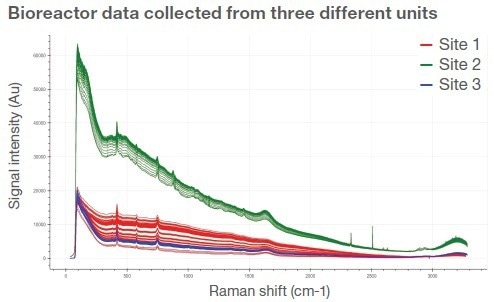For efficient operation, biopharmaceutical production needs a stream of compositional data that is nearly constant. When compared to conventional physical sampling-based measurements, the solid-state process Raman is a proven technology for gathering that data while significantly lowering maintenance and operating costs.
The composition measurements are useful for understanding a bioprocess, but ultimately, this data should be used for optimization and control.
The compositional information can be processed to achieve this goal using data science tools and packages that create reliable predictive models for crucial processes. These models can be quickly deployed to various Raman systems once they have been created and validated.
To optimize the bioprocess, the predictive models’ deployment will provide information that can be put into practice, such as when feeds or controls should be turned on.
To show how simple it is to add value with an all-in-one portable and scalable Raman system, this article will break down the straightforward process of developing and implementing quantitative Raman solutions.
Creating a model for glucose
Cells in the biopharmaceutical manufacturing process need a glucose-feeding cycle to support cell division. Modeling the glucose content of a bioprocess and predicting when to add more glucose to ensure that cells are produced at a precise rate are two functions of the Thermo Fisher™ MarqMetrix™ All-In-One Process Raman Analyzer.

Image Credit: Thermo Fisher Scientific-Handheld Elemental & Radiation Detection
Global data for a global solution
The process of gathering data is the first step in creating this model. The information displayed below is drawn from three data sets that were gathered from various processes using various MarqMetrix™ All-In-One Process Raman Analyzers in various parts of the world.
A robust glucose prediction model was constructed quickly. Although the combined data at first appeared to be quite disorganized, cleaning up the data and making everything work well together was easier.
Due to the MarqMetrix™ system’s stability and the available data science tools, this task was relatively simple. A “global” glucose model was created using the data after they had been cleaned (pretreated).

Image Credit: Thermo Fisher Scientific-Handheld Elemental & Radiation Detection
The power of preprocessing
Three key characteristics of the MarqMetrix™ All-In-One Process Raman Analyzer—stability, reproducible sampling interface, and factory calibration—have a significant impact on how easily data can be preprocessed. No matter where the fleet is located, these characteristics guarantee that every Raman system is incredibly accurate, stable, and consistent with other Raman systems.
From this starting point, basic preprocessing techniques can be used that pinpoint and amplify the pertinent signals in the Raman data. As a result, a predictive model was created that offers improved precision and accuracy when used with various MarqMetrix™ All-In-One Process Raman Analyzers.
Knowing when to feed bioprocess with data science
The predictive model can be used with any MarqMetrix™ All-In-One Process Raman Analyzer after it has been created. The glucose model was applied to data outputs from a fourth MarqMetrix™ system, enabling real-time monitoring of glucose concentration.
The graph below shows users where the bioprocess has been fed more glucose, as indicated by the spikes. As the glucose levels decline over time, it is necessary to feed the bioprocess to keep it in check once a minimum value is reached.

Image Credit: Thermo Fisher Scientific-Handheld Elemental & Radiation Detection
Companies can take concrete actions to improve the management of their processes, thanks to the solution offered by the combination of the MarqMetrix™ All-In-One Process Raman Analyzer hardware and data science tools. One application where modeling can provide a useful solution is glucose monitoring.
About Thermo Fisher Scientific – Handheld Elemental & Radiation Detection
Founded more than 25 years ago, we are the pioneer in portable x-ray fluorescence (XRF). With more than 35,000 instruments installed worldwide, we maintain offices in Munich, Germany, and Hong Kong, in addition to our headquarters outside Boston, Massachusetts, USA.
A culture of innovation and a distinguished history of breakthrough achievements have defined our Thermo Scientific portable XRF analyzers since we introduced the first handheld XRF instrument in 1994. Many “firsts” have followed, including the:
- First use of miniaturized x-ray tubes in one-piece handheld analyzers
- First and only isotope-based handheld analyzer that never requires source replacement
- First handheld analyzer equipped with an He purge for direct analysis of Mg, Al, Si, P, and S in metal alloys
- First handheld small-spot XRF analyzer
- First handheld analyzer to feature a 50kV x-ray tube
- First geometrically optimized large area drift detector
The company has been awarded numerous patents and has received many honors and awards, including an unprecedented three R&D 100 Awards…in 1995 for the Thermo Scientific Niton XL-300, in 2003 for the Niton® XLi and XLt Series, and, most recently, in 2008 for the Niton XL3t Series.
- Handheld and mobile Thermo Scientific portable XRF analyzers, from our value-leading Niton XL2 instrument to our Niton FXL field x-ray lab, are engineered for accurate and reliable on-site elemental analysis and ease of use. These nondestructive analyzers are used for a variety of applications, including:
- Identification and analysis of metal alloys, including precious metal & jewelry analysis
- Mining and exploration
- Testing for lead, cadmium, and other hazardous substances in toys, jewelry, apparel, and other consumer goods
- Compliance testing for RoHS, WEEE, and ELV regulations
- Environmental analysis – site assessment, monitoring, and clearance testing
- Lead-paint inspection
We are committed to making the highest performance, easiest to use, most economical portable XRF analyzer in the world…giving you the tools that help you work more productively than ever before…and enabling you to make the world healthier, cleaner, and safer.
Sponsored Content Policy: News-Medical.net publishes articles and related content that may be derived from sources where we have existing commercial relationships, provided such content adds value to the core editorial ethos of News-Medical.Net which is to educate and inform site visitors interested in medical research, science, medical devices and treatments.